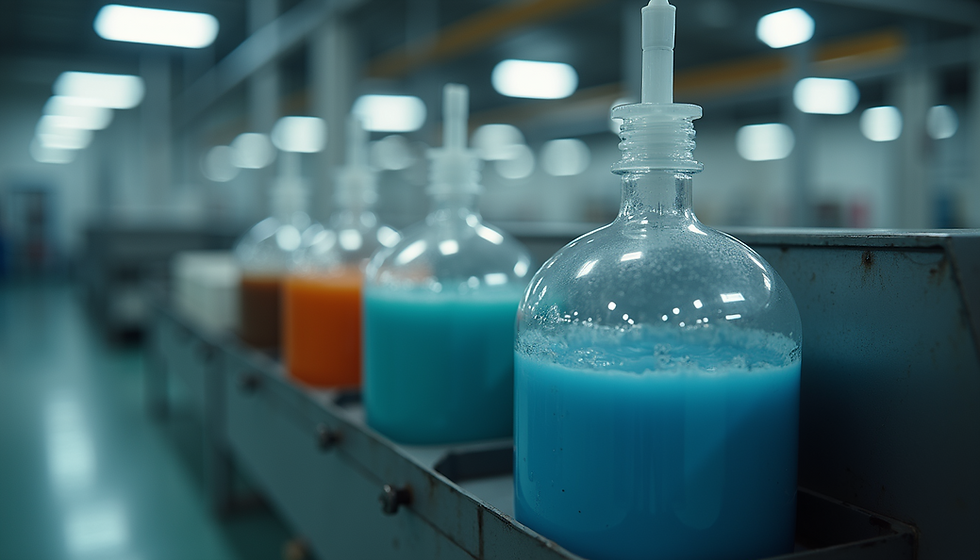Understanding the Basics of Organic Chemical Compounds
- biofm9
- Oct 13
- 4 min read
Organic chemical compounds are the foundation of life and many materials we use daily. These compounds primarily consist of carbon atoms bonded with other elements such as hydrogen, oxygen, and nitrogen. Understanding the basics of organic compounds is essential for grasping how living organisms function, how materials are created, and how chemical reactions occur in everyday life.
Organic compounds are incredibly diverse, ranging from simple molecules like methane to complex structures like proteins and DNA. This article will explore the fundamental concepts of organic compounds, their structures, types, and significance in various fields.
What Are Organic Compounds?
Organic compounds are chemical substances that contain carbon atoms covalently bonded to other elements. Carbon's unique ability to form four stable covalent bonds allows it to create a vast array of complex molecules. This versatility is why carbon is often called the "backbone of life."
Key Characteristics of Organic Compounds
Carbon-based structures: Carbon atoms form chains, rings, or frameworks.
Hydrogen presence: Most organic compounds contain hydrogen atoms.
Functional groups: Specific groups of atoms within molecules determine their chemical properties.
Covalent bonding: Atoms share electrons to form stable molecules.
Examples of Organic Compounds
Methane (CH4): The simplest hydrocarbon.
Ethanol (C2H5OH): Common alcohol found in beverages.
Glucose (C6H12O6): A sugar essential for energy in living organisms.
Understanding these basics helps in recognizing how organic compounds behave and interact in different environments.

Types of Organic Compounds and Their Importance
Organic compounds are classified based on their structure and functional groups. These classifications help chemists understand their properties and reactions.
Hydrocarbons
Hydrocarbons consist only of carbon and hydrogen atoms. They are divided into:
Alkanes: Single bonds (e.g., methane, ethane)
Alkenes: One or more double bonds (e.g., ethylene)
Alkynes: One or more triple bonds (e.g., acetylene)
Aromatic hydrocarbons: Contain benzene rings (e.g., benzene)
Functional Groups
Functional groups are specific groups of atoms that give organic compounds their characteristic properties. Some common functional groups include:
Hydroxyl (-OH): Found in alcohols.
Carboxyl (-COOH): Present in carboxylic acids.
Amino (-NH2): Found in amines and amino acids.
Carbonyl (C=O): Present in aldehydes and ketones.
These groups influence the compound's reactivity, polarity, and solubility.
Importance in Daily Life
Organic compounds are everywhere:
Pharmaceuticals: Many drugs are organic compounds.
Plastics: Made from synthetic organic polymers.
Food: Carbohydrates, fats, and proteins are organic molecules.
Energy: Fuels like gasoline and natural gas are hydrocarbons.
Understanding organic compounds helps in fields like medicine, agriculture, and environmental science.

What Foods Are High in Carboxylic Acid?
Carboxylic acids are organic compounds containing the carboxyl group (-COOH). They are common in many foods and contribute to flavor, preservation, and nutritional value.
Common Foods Rich in Carboxylic Acids
Citrus fruits: Oranges, lemons, and limes contain citric acid.
Vinegar: Contains acetic acid, used in cooking and preservation.
Dairy products: Lactic acid is found in yogurt and cheese.
Fermented foods: Sauerkraut and kimchi contain various carboxylic acids.
Health Benefits
Carboxylic acids in foods can:
Aid digestion.
Act as antioxidants.
Help preserve food by inhibiting bacterial growth.
Industrial Relevance
Carboxylic acids are also important in manufacturing. For example, carboxylate chemicals derived from these acids are used in producing biodegradable plastics and pharmaceuticals.

How Organic Compounds Are Synthesized
Organic synthesis is the process of constructing organic compounds through chemical reactions. This field is crucial for developing new materials, medicines, and chemicals.
Basic Methods of Organic Synthesis
Addition reactions: Atoms add to a double or triple bond.
Substitution reactions: One atom or group replaces another.
Elimination reactions: Atoms are removed to form double or triple bonds.
Condensation reactions: Two molecules combine with the loss of a small molecule like water.
Practical Example: Synthesis of Aspirin
Aspirin is synthesized by reacting salicylic acid with acetic anhydride. This reaction introduces an ester functional group, making the compound effective as a pain reliever.
Tips for Successful Synthesis
Understand the reactivity of functional groups.
Control reaction conditions like temperature and pH.
Use catalysts to speed up reactions.
Mastering organic synthesis opens doors to innovation in chemistry and industry.
The Role of Organic Compounds in Everyday Products
Organic compounds are integral to many products we use daily. Their diverse structures allow for a wide range of applications.
Common Products Containing Organic Compounds
Cosmetics: Contain organic compounds like alcohols, esters, and oils.
Cleaning agents: Surfactants and solvents are organic molecules.
Textiles: Synthetic fibers like nylon and polyester are organic polymers.
Pharmaceuticals: Most medicines are organic compounds designed to interact with biological systems.
Environmental Considerations
While organic compounds are useful, some synthetic ones can be harmful to the environment. Biodegradable alternatives, often based on natural organic compounds, are gaining popularity.
Future Trends
Development of green chemistry to reduce waste.
Use of renewable resources for organic compound production.
Advances in biotechnology for organic synthesis.
Understanding the role of organic compounds helps consumers make informed choices and supports sustainable development.

Expanding Your Knowledge of Organic Chemistry
Organic chemistry is a vast and fascinating field. To deepen your understanding:
Study molecular structures: Use models or software to visualize compounds.
Learn functional groups: Recognize how they affect properties and reactions.
Practice synthesis problems: Apply knowledge to create new compounds.
Explore real-world applications: Connect theory with everyday products and processes.
By building a strong foundation, you can appreciate the complexity and beauty of organic compounds and their impact on science and society.
Organic chemical compounds are essential to life and technology. From the food we eat to the medicines we take, understanding their basics empowers us to appreciate the world at a molecular level. Whether you are a student, professional, or curious learner, exploring organic chemistry opens up endless possibilities for discovery and innovation.







Comments